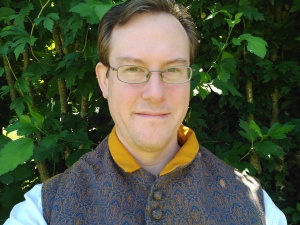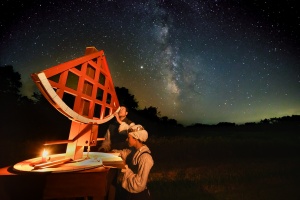Jon Chesey
- aka "Cheesy Jon"
Jon lives in Barony of Three Rivers and has been an active participant there since ~2016 after taking a long break from the SCA due to school and real life. His primary interest is rattan combat, but he is also well known for his work in astronomy, bardic, costuming, and voice heraldry.
Persona
Jon's persona in the SCA took a long time to crystallize, but was eventually derived from his interest in astronomy as the tools and methods that captured his interest were only available at the very end of the SCA period. As such, Jon Chesey is a late 16th century Englishman, the latter son of a lord, releasing him from burdensome expectations of taking over the estate. Instead, Jon was free to travel and pursue his interest in astronomical sciences. He would have studied the works of Ptolemy and Copernicus, learned instrumentation from Brahe.
History in the SCA
- Started in the SCA in 1999 after being introduced by Sir Donato el Lobo
Awards
- AoA: February 2004
- Iren Fyrd: June 2017
- Torse: March 2018
- Leather Mallet: September 2018
- Golden Calon Swan: May 2019
Groups and Affiliations
- Current Group: Barony of Three Rivers
- Previous Groups:
- Shire of Oakheart (2002 - 2005)
- Shire of Carlsby (2005 - 2009)
Offices
- Baronial:
- Herald for Barony of Three Rivers (2016 - 2019)
- Gold Key for Barony of Three Rivers (2018 - Current)
- Webminister for Barony of Three Rivers (2021 - Current)
- Kingdom
- White Hawk Herald for Anton IV and Yseult, 72nd Crown (2019 - 2020)
Events Run
- Winter Court 2018 - A Norse Yule Celebration
- Gryphon's Fest 2019 - A Merry Band of Thieves
- Gryphon's Fest 2021 - Our Saints Weekend
- B3R Friday Night Bardic 2020 - 2021 (Online)
- B3R Online Feast
Championships
- Rattan fighting champion for Barony of Three Rivers 2016-2017
Original Research
Mathematical Astronomy
In 2017, Jon discovered an image of a 16th century astronomical toolkit. The toolkit contained several small instruments, but also included tables that would have been used to predict the time and location of various objects in the night sky. Mundanely, Jon has a degree in astronomy and began wondering how such tables were calculated in period. Specifically, he was interested in how astronomers in period, used the geocentric and heliocentric models to make planetary predictions.
As such, Jon started trying to investigate this by reading Kepler's Astronomia Nova. But despite his familiarity with modern astronomy, he found the context in which Kepler was framing his discussion sufficiently foreign that Jon would need to get a better understanding the foundational principles of astronomy in the 16th century. Since the de facto model at the time was still based in the Ptolemaic geocentric model, Jon decided to start by working through Ptolemy's 2nd century Almagest. He began this project in early 2018 and based on the current rate of progress, is expected to finish this text in late 2025 or early 2026.
As Jon works through this text, he has been explaining the text in his blog. This is an important contribution to the field as there is little material available to help readers understand the text. While the Almagest does have an English translation (from which Jon is working), the translator offers scant commentary to assist readers in this difficult text. While there are a few other texts that have looked at this work, they do not deal with it in its entirety and often use modern math to approach the topics. As such, Jon's blog is the first time in modern history that the Almagest is being explained in its entirety in its own context.
Observational Astronomy
The astronomical models Jon has been studying rely on a theoretical model that still needs to be calibrated based on real observations. As such, Jon has taken an interest in the tools astronomers used to make observations.
The Great Quadrant
The first instrument Jon built (with help from his father who is a carpenter mundanely) was an astronomical quadrant based on one originally built by Tycho Brahe in 1569. The quadrant was built over the summer of 2018 and disassembles for easy transport. The instrument is leveled with screws in each corner that, while not in the original design by Brahe, was found in his later instruments. To tell if it is level, a plumb hangs from the central axis above a mark which indicates when it is level. The wire for the plumb also hangs in front of the scale for the instrument to indicate where the reading should be taken from.
When first built, the quadrant was only able to measure in one direction - the up-down, known as altitude, used for measuring the angle of an object above the horizon. This, along with the angle along the horizon from north (the azimuth), the observer's latitude, and the time measured with respect to the stars instead of the sun (sidereal time), can be used to determine the coordinates of an object in a coordinate system affixed to the sky to provide a single reference frame for all objects. To ensure that observers using this instrument would know the azimuth, the instrument was originally aligned north-south by sighting the north star, Polaris, and then locking it in that position so it could no longer rotate in that plane. This meant that observers would have to wait for objects in the sky to rotate into position for the instrument to be able to observe them - a tedious task. To solve this problem, a second scale was added in the azimuthal plane in late 2020. Now, during setup, the instrument is aligned on north, but the new azimuth ring is then set for this and the instrument can be pointed anywhere in the sky and the azimuth determined.
This instrument was featured in the June 2021 issue of Sky & Telescope Magazine
Observational Goals
Calibration & Testing of Astronomical Models
In order to have the necessary observations to properly calibrate and test the astronomical models Jon is studying, Jon seeks to take frequent observations. However, the observations necessary for calibration occur only when planets are directly opposite the earth from the sun which happens quite infrequently. Additional observations at other times will be necessary to test the models, but observations for this goal are rare.
Star Map/Catalog
Since the primary function of observing planets for modeling is not demanding, Jon seeks to use the quadrant for other astronomical goals. In particular, he is working to build a catalog of the position of stars based on his observations. This is inspired by the 1603 publication the Uranometria which took Tycho's observations and turned them into illustrated star maps. At present, Jon's catalog has over 400 individual objects comprised of over 800 observations.
Classes Offered
Bardic
- History of Calontir through Song
Astronomy
- A Brief History of Medieval Astronomy
- Christianity and Astronomy in the Medieval Period
- Movement of the Heavens
- De Sphaera (On the Sphere)
Activities
- Rattan fighting
- Bardic singing
- Mathematical & Observational Astronomy
- Costuming
- Brewing & Vinting
- Voice Heraldry
In Case of Court
No special preferences. Surprises are fine.
Rat out a Friend
Too Many Sons - song written to be performed at Gulf Wars XXIX 2020: The War That Never Was


